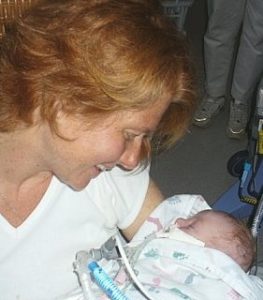Grief and Suicide
by Rebecca Hensler
[Content notes: The following entry involves discussion of suicidal ideation, suicide prevention, and a death by suicide, all in the context of grief. As always at Grief Beyond Belief, please keep comments free of religious or spiritual content.]
The following is entirely the personal thoughts of the author, except where cited through links.
When my son died, I did not want to stick around.
Maybe part of what is hard about suicide prevention, just like prevention of other violence, is that we are trying to find one answer for a problem as varied as those who suffer from it. Despite years of research we know very little about suicide and why, when two people have similar situations, support and resources, one chooses to live and the other to die. But it occurs to me that to help someone choose to stick around, perhaps the first step is to observe and listen and know them.
This could be why a safety plan may work, when a no-harm contract does not. A no-harm contract depends on the idea that a commitment made to a counselor, therapist, social worker or other mental health provider will be strong enough to prevent suicide. A safety contract engages the person who is experiencing suicidal thoughts in a cooperative exploration of what triggers those thoughts and what strengths, strategies and relationships help that person survive until the thoughts recede. It requires at least some degree of the kind of knowledge that Andrea had of me when she used my own drive to take care of those who need me to motivate me to remain alive.
But because knowing someone that well is often impossible for a mental health provider, writing a safety plan involves a more immediate kind of information: What places, activities and people make you feel okay when you are at your lowest and most desperate? What are you willing to do to help yourself or to seek help in that moment? Who can you reach out to? Who can you reach out to if they aren’t available? Who else? And a safety plan lays it all down on paper — along with hotline and textline numbers — so that you don’t need to remember your strategies and support when you are least able to do so. For a suicidal or self-harming person, it puts the means of accessing resources, internal and external, as close or closer at hand than the means of harm.
I’m going to be writing more about this topic next week when I propose a safety plan for grief, a plan for what to do when we are overwhelmed with sorrow and longing. For now I would like to return to the topic of suicide.
The thing is, I know I am far from alone in having experienced suicidal thoughts when my child died. It has been my observation that suicidal ideation is common among grieving people. So common that, although responding to posts about not wanting to live is among the most intense challenges of moderating an online peer-to-peer support group, we are not willing to ban these posts at Grief Beyond Belief Closed Group. If you cannot talk about wanting to die in your grief group, where can you talk about it? But every time it happens in the group, I think “Oh shit, here we go,” and quickly contact the volunteer group moderator who is the most highly trained and experienced in mental health to try to assess the situation. Since I co-founded the closed group in 2012, it’s been a rare Christmas Eve that hasn’t involved panicked efforts to contact a suicidal group member and worried checks the next morning to make sure that member is still with us.
We have lost members to suicide. I know that grief alone was not the cause. Depression, despair, trauma, physical pain, isolation… People end their lives for so many reasons and my observations suggest that it is almost never just one.
My lover Kaci ended their life three years to the day after their best friend Colin died of AIDS. That’s how I knew for sure that their overdose was not accidental. But I don’t think grief alone would have killed Kaci, If their father had not been abusive, if treatment for addiction were easier to access and more humane, if post-treatment housing weren’t a fleabag SRO in the Tenderloin, if there had been a place in the world for them, Kaci might still be here. Grief was a factor, but just one piece of an unsolvable puzzle for Kaci.
My own experience teaches me that being seen, heard and known is one key to surviving grief. I realize now how lucky I was that Andrea and others were willing to sit with me while I said over and over again, “I want to die,” and responded, “I know,” instead of “Don’t say that.” I also know that this would not be enough for everyone.
I honestly don’t think that any one answer is enough. I think that we need to do All Of The Things to prevent humans in pain from ending their own lives: Make it harder to get the means (read this article if you don’t think the 10-day waiting period to get a gun makes a difference). Make it way easier and more affordable to access high-quality mental health care, because when you are experiencing suicidal ideation is when you are least capable of navigating a labyrinthine health care system. Take everyone, including kids, teenagers, those with disabilities and the elderly, seriously when they tell you they are suffering. Stop glorifying and romanticizing suicide in the media and making it look like an attractive answer while vilifying the very people trained to help prevent suicide (I’m looking at you 13 Reasons Why). Fight personal and institutional biases and bigotry that result in preventable trauma (I’m looking at you white supremacy). Use restorative practices and restorative justice when possible to redress wrongs without shaming and isolating the wrongdoer. Stop throwing spaghetti at the wall when it comes to bullying behavior and identify and fund evidence-based practices that do more than make educators feel like they are doing something to help. Pay public mental health professionals, outreach workers, school counselors and social workers as if we are protecting your precious loved ones from harming themselves and others. Ensure that those who are grieving are offered more than thoughts and prayers and that mental health care and grief-support are not just available but appropriate for each grieving individual including those of us grieving without faith. Do not blame, shame, or isolate those who are grieving a loss or losses to suicide.
But even if we do all those things and more, there will be deaths by suicide. We simply do not have the answer to this question, perhaps because we keep looking for the answer instead of a better understanding of the many and myriad factors that lead human beings to end their own lives. When it comes to grief-related suicide, we need to explore what factors, conditions and support help a person live with grief, even when it hurts so much that it doesn’t seem survivable.
And let us not forget that ending all suicide is not a compassionate goal. Assisted suicide for those who are experiencing unbearable, incurable, chronic pain and suffering from terminal illness must be legalized rather than hidden and criminalized.
That said, my personal opinion is that we must do what we can as individuals and a society to prevent the vast majority of suicides, including those motivated primarily by grief. If someone you love is grieving and suicidal, find the strength to listen without asking them not to feel what they feel or not to speak of it. If you know them well enough to know what drives them and gives their life meaning — as my wife knew me nine years ago when our son died — remind them gently. Be ready to have anything you say rejected on first hearing and do not take it personally. Remember that when you are supporting the grieving, it isn’t about you. Listen, listen, listen, and if they do not want to talk, be ready to sit quietly with their pain. Hold space and bring a hot dish.
As long as a grieving person is simply talking about what they feel or want (“My life is pointless now.” “I want to die.”) you can encourage and help them to access professional mental health care. A person who is grieving without belief in an afterlife may particularly benefit from mental health services that are certain to be free of religious or spiritual assumptions or projections. If the grieving person has a plan and the means to end their own life, do absolutely everything you can to get them professional help, including driving them to a psychiatric unit if one is available or an emergency room if one is not. If your area has a mental health crisis team, look up the number and have it available just in case you need it. If you have a child or teenager — or know children or teenagers — find the number for the nearest child crisis services and keep it in case you need it.
And if you yourself are experiencing thoughts of suicide or have in the past, find a hotline number (800-273-8255 in the US) or a crisis text line (741741 in the US) and use it when you need it.
As I mentioned earlier, next week I will be writing about my idea for a safety plan for when grief is overwhelming. In the meantime, please be gentle with yourself. I’m not going to promise you that it gets better, but we can learn to live with grief. I’m still here and you are too. Let’s keep it that way.


Leave a Reply
You must be logged in to post a comment.